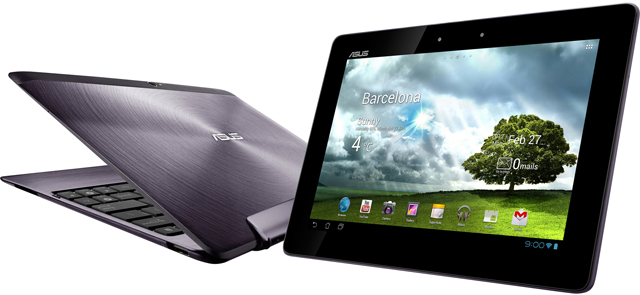Once upon a time the Asus Eee brand held some weight. The Eee name debuted with Asus’ netbook line, which nearly instantly set the bar for low-cost, but still quality, computing devices. That’s why the Eee brand was used for Asus’ first tablets. But now, in 2012, with netbooks quickly fading into irrelevance, Asus wisely decided it was time to retire the name. From here on out Asus tablets will be known as Transformer Pads.
Along with the rebranding, Asus also used the Mobile World Congress stage to announce two new tablets. The TF Pad Infinity is the first model in the new high-end Infinity line while the TF Pad 300 aims for the budget market. Both are styled similarly to the original Transformer Prime but seem to pack slightly different components that shouldn’t cause as many headaches with non-functioning components. Sorry, early adapters. You were beta testers. Both of these models are better equipped than the two-month old Transformer Prime.
The Transformer Pad Infinity is 8.5mm thick but still packs either a dual-core Qualcomm Snapdragon S4 for the 3G version or Tegra 3 for the Wi-Fi model. A 10.1, 1920×1200 Super IPS+ screen resides up front and is covered with Gorilla Glass 2. Inside is 1GB of RAM, 16/32/64GB of storage and 2MP front facing and a rear-facing 8MP camera. It will ship with Ice Cream Sandwich sometime in the second quarter for at unannounced price points.
The TF Pad 300 more closely lines up with the current Transformer Prime. It packs a Tegra 3 chip, 8MP/2MP cams, and HDMI-out. The main difference comes in storage size and screen resolution: The TF Pad 300 only rocks 16GB of onboard storage and the screen is a standard IPS screen with only 1280×800 resolution. This tablet will also ship with ICS sometime later this year. No word on price yet.
Both models will have optional keyboard docks that not only add ports but also feature additional batteries.
It seems Asus learned its lesson from the original Transformer Prime. Both of the new Transformer tablets have a plastic strip on the otherwise all-aluminum back plate for improved Wi-Fi and GPS reception.
Both of these tablets will launch later this year with the current shipping window sometime in the second quarter. By that time the iPad 3 will also be shipping, which will likely overshadow the rest of the tablet market for several months. Asus probably knows this and scheduled these tablet’s launches until there’s room to breathe again. Besides, even with connectivity issues, the company’s Transformer Prime still is still winning the Android tablet spec race. There’s no reason to replace it just yet.
